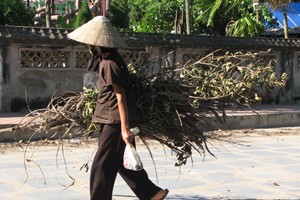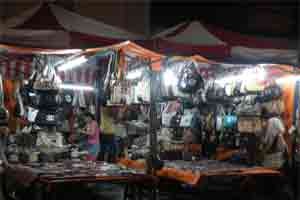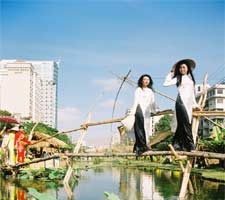There is a story about how thousands of years ago, during the 6th Hung dynasty, a three-year-old boy appeared to drive out foreign invaders with a bamboo stick. Though obviously a myth, the story symbolizes the bamboo’s importance in Vietnamese history.

In the modern era, bamboo ramparts offered protection and hiding places to the Vietnamese army during the war and punji sticks made of bamboo stakes were lethal booby traps.
The plant, which is actually a grass, is so symbolic of Vietnamese spirit and culture that it has earned itself a hallowed place in literature, folk music, and stories. School children are taught the legend of the poor farmer who managed to marry his feudal lord's beautiful daughter by procuring with the help of God a bamboo tree with 100 knots.
Then there is the poem “Tre Viet Nam”, or Vietnamese bamboo, that every high school student has to learn:
“Tre xanh
Xanh tự bao giờ
Truyện ngày xưa đã có bờ tre xanh
Thân gầy guộc, lá mong manh
Mà sao nên luỹ, nên thành tre ơi
Ở đâu tre cũng xanh tươi
Cho dù cát sỏi đá vôi bạc màu…
Loài tre đâu chịu mọc cong
Mới lên đã thẳng như chông lạ thường”
(Green bamboos
They are green from time immemorial
Ancient stories mention green bamboo hedges
Their stems are thin, leaves slender
But they can become ramparts and citadels
They are green everywhere
Be their land infertile filled with pebbles and limestone…
Bamboos trees always grow up straight
Even when it is still very young, it stands surprisingly straight like a punji stick)
Eternal, undaunted spirits
Being evergreen, fast-growing, tall, straight, and very flexible, the plant has for centuries come to represent the strong, straightforward, but resilient character of the Vietnamese.
The Vietnamese consider bamboo one of the four noble plants symbolic of the nation’s spirit and its endurance, the other three being mai (apricot), lan (orchid), and cuc (chrysanthemum).
A popular proverb: “tre gia mang moc” (When the bamboo is old, sprouts will appear), indicates that very durability: though the previous generation dies, the next takes its place and, thus, the Vietnamese nation and its values will always be sustained.
In fact, bamboo was the first species of plant to regenerate after the Americans destroyed Vietnam’s forests using the dioxin Agent Orange. It is also one of the fastest growing plants in the world.
Some scientists theorize that Vietnam’s is a “bamboo” rather than the popularly accepted “wet-rice” culture.
Utility
The bamboo is probably the plant with the widest array of uses in the world. When treated, bamboo is a very hard wood which is both lightweight and exceptionally tough and can be made into furniture, home decorations, lawn and garden accessories, fences, poles, hats, martial arts weapons, and scaffolding for construction, woven as handicrafts or baskets, and used as a substitute for steel to reinforce concrete.
It is also used to build bridges, toilets, walking sticks, canoes, tableware, fishing rods, smoking pipes, and kite frames.
Every meal in Viet Nam will feature the ubiquitous chopstick. Though now chopsticks are also made from plastic or even ivory, they are traditionally and predominantly made from bamboo.
The plant has also found its way into the world of traditional music -- instruments like flutes and dan bau (monochord) are made from it. Houses and restaurants across Viet Nam use bamboo stems and leaves in their floors, walls, roofs, and furniture.
The shoot of the bamboo is used in a variety of Vietnamese recipes.
Shaved young shoots, the resin (both fluid and dried), and leaves are considered to have medicinal properties and can clear body ‘heat’ and phlegm, cure acute fevers, convulsions, bleeding, and vomiting.
Of the many plant species in Viet Nam, probably none is as widely distributed and as close to the life of the people as the bamboo.
There are estimated to be 200,000 square miles of bamboo forests and nearly half of all villages across the country grow bamboo.
The tree is considered as a mascot against bad luck as people believe unhappiness can be driven out and good fortune ushered in if they plant a tall bamboo in front of their homes during the Lunar New Year (Tet).
The tradition continues until this day with bows, arrows, bells, and gongs hung on this special tree which is called “cay neu”.
























